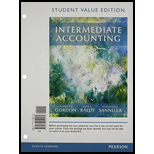
Basis for Conclusions Cases
Basis for Conclusions Case 1: Liquidation Accounting
If liquidation is imminent for an entity then the company must use the liquidation basis of accounting. The rules for the liquidation basis of accounting were set forth in ASU 2013-07 and subsequently incorporated into the codification. When the FASB was deliberating on the issue of the liquidation basis of accounting, the board addressed when the entity should start applying liquidation accounting Originally, prior to issuing an exposure draft. FASB had decided that liquidation would be considered imminent when the plan for liquidation had been approved by the parties that had the authority to do so.
1 What problem did the FASB discover with this approach? What did it then conclude should be done?
Later the FASB issued an exposure draft on the liquidation basis of accounting Many of the respondents to the exposure draft expressed a concern with the definition of “imminent.”
2 What concern did the respondents express? What was the board's response? Other issues related to the liquidation basis of accounting involve the measurement bases used. The recognition bases under liquidation accounting are generally inconsistent with the measurement used in general-purpose financial statements
3. How did the FASB respond to this contradiction within its own framework?
The FASB concluded that in measuring assets under the liquidation basis of accounting, the entity should measure the assets based on the amounts it expects to receive
4 Why did the FASB not just state that the measurement should be based on fair value? Is it correct that fair value is the same as the amounts the entity expects to receive in liquidation?
The FASB also concluded that liabilities should not be written down until the entity is legally released from them
5. What was FASB s reasoning for this conclusion?
Want to see the full answer?
Check out a sample textbook solution
Chapter 6 Solutions
Intermediate Accounting - Myaccountinglab - Pearson Etext Access Card Student Value Edition
- Can you explain this financial accounting question using accurate calculation methods?arrow_forwardI am looking for help with this financial accounting question using proper accounting standards.arrow_forwardI am looking for help with this general accounting question using proper accounting standards.arrow_forward
- Please provide the correct answer to this financial accounting problem using accurate calculations.arrow_forwardI am searching for the right answer to this financial accounting question using proper techniques.arrow_forwardPlease help me solve this financial accounting question using the right financial principles.arrow_forward
- Can you solve this financial accounting problem with appropriate steps and explanations?arrow_forwardCan you show me the correct approach to solve this financial accounting problem using suitable standards?arrow_forwardI am looking for help with this general accounting question using proper accounting standards.arrow_forward
- I need assistance with this financial accounting problem using valid financial procedures.arrow_forwardPlease provide the correct answer to this general accounting problem using accurate calculations.arrow_forwardPlease provide the correct answer to this general accounting problem using accurate calculations.arrow_forward
 Intermediate Accounting: Reporting And AnalysisAccountingISBN:9781337788281Author:James M. Wahlen, Jefferson P. Jones, Donald PagachPublisher:Cengage Learning
Intermediate Accounting: Reporting And AnalysisAccountingISBN:9781337788281Author:James M. Wahlen, Jefferson P. Jones, Donald PagachPublisher:Cengage Learning Intermediate Financial Management (MindTap Course...FinanceISBN:9781337395083Author:Eugene F. Brigham, Phillip R. DavesPublisher:Cengage Learning
Intermediate Financial Management (MindTap Course...FinanceISBN:9781337395083Author:Eugene F. Brigham, Phillip R. DavesPublisher:Cengage Learning
- Principles of Accounting Volume 1AccountingISBN:9781947172685Author:OpenStaxPublisher:OpenStax College
 Auditing: A Risk Based-Approach to Conducting a Q...AccountingISBN:9781305080577Author:Karla M Johnstone, Audrey A. Gramling, Larry E. RittenbergPublisher:South-Western College Pub
Auditing: A Risk Based-Approach to Conducting a Q...AccountingISBN:9781305080577Author:Karla M Johnstone, Audrey A. Gramling, Larry E. RittenbergPublisher:South-Western College Pub




